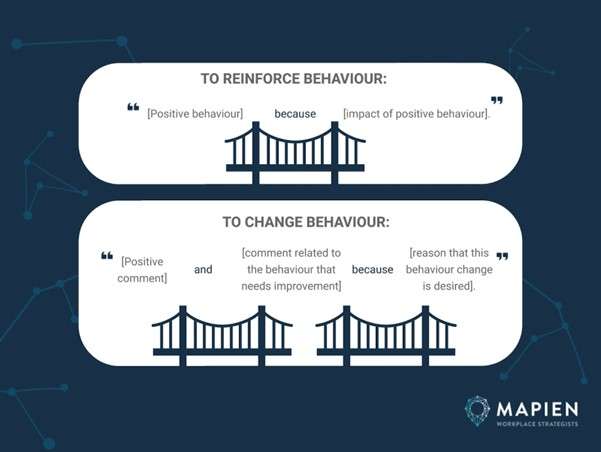
Applying the Feedback Bridge to give constructive feedback
This is blog #10 in our series on coaching models. Sign up to our mailing list to make sure you don’t miss out on our future content.
Are you confident in your ability to deliver feedback in the workplace?
Feedback can be a powerful tool for motivation, engagement, growth, wellbeing, satisfaction, development, and organisational performance. But it can have a positive or negative impact, depending on the type of feedback and how it is delivered.
As a leader, delivering feedback in the best possible way will benefit your colleagues — and your organisation as a whole. We’ve got a coaching model (and some practical tips) to help you make the most of every opportunity to share feedback.
Introducing the Feedback Bridge

You might’ve heard of The Feedback Sandwich (or hamburger), which involves sandwiching constructive criticism in between positive feedback. But there’s another feedback model you may not have heard of: The Feedback Bridge!
The Feedback Bridge helps to structure your conversations when giving feedback — whether you want to reinforce positive behaviours or encourage a shift in behaviour.
It helps you, the feedback-giver, to build a bridge between the current situation and the desired future situation. And ideally, it also helps to build or reinforce the connection between yourself and the feedback recipient.
If you’re not yet confident on how to give feedback, it’s the perfect place to start.
How to apply the Feedback Bridge
The Feedback Bridge can be used to plan your conversation ahead of time, ensuring that you touch upon key points of feedback and insight in a way that’s effective, considerate, and most likely to have the desired effect. We’ve broken this method down into four key steps, along with some examples.
Step 1: Identify behaviour & reflect
The first step is to identify the behaviour you’d like to focus your feedback on. It could be positive behaviour that you want to reinforce, or unwanted behaviour that you want to encourage them to change. We’ve included one example of each below:
| Behaviour Example | |
| Positive Behaviour | Going out of their way to collaborate with other teams. |
| Negative Behaviour | Frequently showing up late or unprepared for meetings. |
Step 2: Consider the impact & keep it positive
Whether you’re planning to reinforce a positive behaviour or change a negative behaviour, you’ll need to address why you wish to encourage or change the behaviour. Reflect on what the impact of that behaviour is and how you’ll bring that up in conversation. For example:
| Behaviour Example | Impact | |
| Positive Behaviour | Going out of their way to collaborate with other teams. | This helps build capabilities and knowledge, reinforces our sharing culture, and strengthens relationships within our organisation. |
| Negative Behaviour | Frequently showing up late or unprepared for meetings. | This makes others feel disrespected and wastes their time. It also doesn’t accurately reflect your abilities as a professional. |
Note: if your feedback will be focused on changing an undesired or negative behaviour, there’s an extra step involved. You should start with a positive comment (that’s relevant to the situation) with your feedback. This will help to:
- Keep your perspective balanced and focused on the big picture (it’s not all bad!)
- Soften the blow of any negative points you’re about to share
- Prepare the recipient to be open to critical feedback
- Boost the recipient’s self-esteem and motivation
In the negative behaviour example shown above, you might like to start with one of the following positive comments:
|
Step 3: Fill out the Feedback Bridge
To complete your preparations, write down everything from steps one and two, following the structure of The Feedback Bridge. Note how each of your comments should be connected by words like “because” or “and” — this links your feedback to the reasons behind it.
You might like to recreate a simple version of The Feedback Bridge to fill out, or copy-paste the following templates:
Reinforcing positive behaviour
| Positive Behaviour | Impact of Positive Behaviour | ||
| ______________________________________ | because | ______________________________________ | |
| ______________________________________ | ______________________________________ | ||
| ______________________________________ | ______________________________________ | ||
| ______________________________________ | ______________________________________ | ||
Changing negative behaviour
| Positive Comment | Behaviour That Needs Improvement | Why Change is Desired | ||||
| _______________________ | and | _______________________ | because | _______________________ | ||
| _______________________ | _______________________ | _______________________ | ||||
| _______________________ | _______________________ | _______________________ | ||||
Step 4: Share your feedback
Finally, it’s time to share your feedback with the intended recipient, ensuring you follow The Feedback Bridge structure to deliver your comments.
For more serious or formal feedback, you should schedule a one-on-one catch up, ideally face-to-face. But if the feedback is more casual in nature, a more informal approach may be more appropriate (in fact, scheduling a meeting could cause unnecessary anxiety!).
We share more about this topic in our previous blog, Workplace Communication: Choosing The Right Communication Channel.
6 tips and principles for effective feedback

In addition to using The Feedback Bridge, we’ve got some additional tips and principles that can help make your feedback more effective and constructive.
Have a clear why
Research suggests that your perceived intent can have an impact on how the recipient reacts to your feedback. So, ask yourself what you want to achieve from the conversation and make your reasons clear from the start. Most importantly, ensure your feedback is focused on benefitting the recipient.
Make it specific
Feedback that is general in nature probably won’t help the recipient and might even confuse them. The feedback you share should be specific and concrete, just like the S.M.A.R.T.(S) goal setting framework we covered previously.
Make it actionable
Your feedback should also be focused on something the recipient can take action on. After all, there’s few things more frustrating than getting criticism about something you cannot control or change.
Keep it positive
One of the reasons we like The Feedback Bridge framework is because it can be used to enforce positive behaviour, and it incorporates positive comments even when change is desired.
When you’re quick to praise and reinforce positive behaviours, you can directly impact efficiency and effectiveness. And one of the best things you can do is praise the effort people put into their work.
Ask for feedback in return
“Feedback is a free education.”
As a leader, you can model how you want your team to receive feedback and respond to criticism. So, if you don’t already have a feedback mechanism in place for your leadership, create one. Ask for feedback and prepare to gain some insights into your own behaviour as you work towards becoming a better leader.
Build your feedback muscle
If giving and receiving feedback feels tricky right now, it might be because you need to do it more often.
Recently, McKinsey shared about a new initiative to encourage their teams to practise having feedback conversations via structured “challenges” delivered over a four week period. Their goal was to help people get comfortable asking for, reflecting on, and taking action on feedback. This initiative resulted in 250 feedback conversations that would otherwise not have happened, and they received many positive comments from those involved.
The takeaway? You can build your feedback muscle over time by simply sharing and requesting feedback on a regular basis!
Explore other methods
There are various other methods for providing feedback to others, and different models may even be better suited to your context or purpose better than The Feedback Bridge. As a starting point, we recommend exploring:
- The Feedback Sandwich
- The Situation-Behaviour-Impact (SBI) Feedback Model
- The Example-Effect-Change/Continue (EEC) Feedback Model
- The Describe-Express-Specify-Consequences (DESC) Feedback Model
Plus, many of the leadership and coaching models we’ve shared previously are useful tools for reflection, behavioural change, and personal development. Take a look at Stealth Expectations, The Circles of Control, Influence & Concern, The GROW Coaching Model, The Stages of Change Model, and The Choice Point Method.
Get support
Looking for support with workplace psychology or more hands-on support for your leadership team? Contact our team to start the conversation today!

